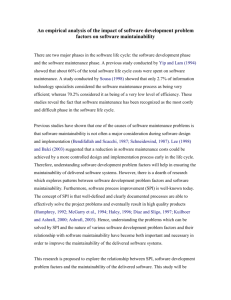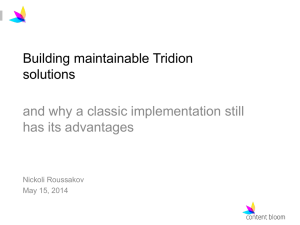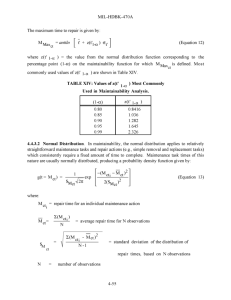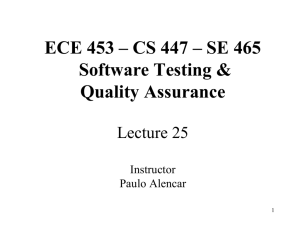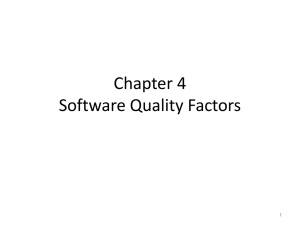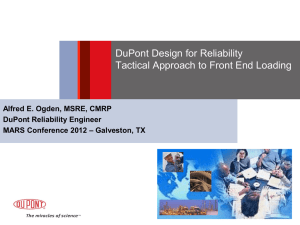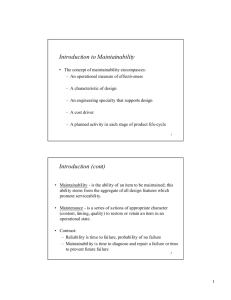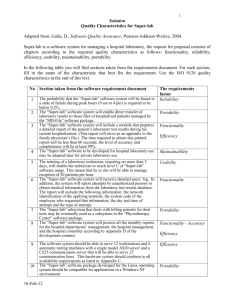Week10-1-CSSE575-MeasurableMaintainability - Rose
advertisement
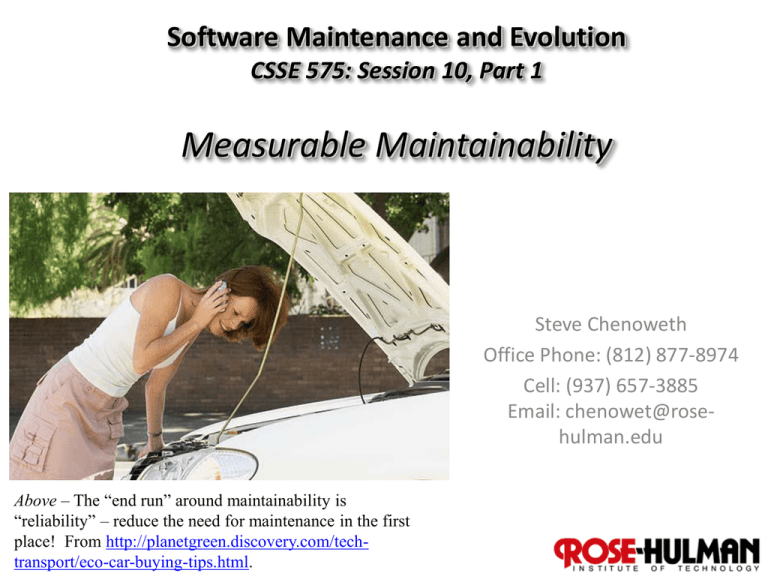
Software Maintenance and Evolution CSSE 575: Session 10, Part 1 Measurable Maintainability Steve Chenoweth Office Phone: (812) 877-8974 Cell: (937) 657-3885 Email: chenowet@rosehulman.edu Above – The “end run” around maintainability is “reliability” – reduce the need for maintenance in the first place! From http://planetgreen.discovery.com/techtransport/eco-car-buying-tips.html. 1 Maintainability – one more time! Where we’ve seen this topic before – Or is it the whole course? • Weeks 1 & 2 - refactoring • Week 4 – discussed keys to maintainability: – – – – Management (to be amplified in our next slide set!) Operational environment of the target systems Documentation, target system software, maturity Modifiability of the code • Localizing changes • Preventing ripple effects • Deferring binding time – Article on “Demystifying maintainability” – • There’s no common understanding of what “maintainability” is • Keys are measurements (this slide set) and manual inspections – Program understanding is also key to maintainability • Week 6 – Feathers – tips on making it easier to test and change OO code • Week 7 – the article on Preventive Maintenance • Week 9 – statistical modeling – a major goal was measure the “pieces of the horseshoe model” to improve maintainability (and lead to tonight’s discussion) – Recommended “things to measure” – Discussed how to automate, to get statistics 2 Getting back to Deming…and Kelvin! • Measuring things is fundamental to any “process control” – – “A process is stable if its future performance is predictable within statistically established limits.” – W Edwards Deming • Or, we can’t manage the darn thing if we can’t measure what’s going on! – “…when you cannot measure it, when you cannot express it in numbers, your knowledge is of a meagre and unsatisfactory kind.” – Lord Kelvin 3 What to measure – It depends! Correction Enhancement Proactive Preventive Perfective Reactive Corrective Adaptive Recall we have different kinds of maintenance… • Some of these tend to be larger scale. • Some tend to be more urgent. 4 When to start measuring - Early • Initiating measurement during pre-delivery – Gives assessment of product quality – Shows product readiness for maintenance – Can use check lists • Just like for first customer delivery • Should have support tools & metrics built-in – Lots of things to “size up” from this point on… 5 Some things to measure - 1 • Application (before maintenance) – Functional size – Lines of code – Environmental characteristics • What the lab has to have for maintenance & testing • Application (after) – Functional size – Lines of code – Environmental characteristics Need Deltas! 6 Some things to measure - 2 • Effort – – Person-days planned • Other costs – Tools – Administrative services Right – the lighthouse is a wellknown symbol for managerial accounting, as portrayed on this well-known textbook about it. 7 Some things to measure - 3 • Maintenance requests – Number – Category • Completed requests – Number – Category – Functional size – Lines of code – Person-days Above – Manny Lehman, of Lehman’s Laws. One of my favorites is “self regulation” that the project size and random facts about the project drive the processes adopted by management. 8 Resources to measure • • • • Employees Tools Budgets Maintenance environment Above – How to manage resources, from Project Management Made Easy, by Aditya Chinni, PMP. 9 Processes to measure • • • • • • • • Predelivery and transition Operational support Corrections Evolutions Change monitoring Regression testing Events management Configuration management 10 Or, 11 Sidebar – What was with Timmy? (I used to do this for a living.) 12 Maintenance products to measure • • • • • • Technical documentation User documentation Source code Object code Reference databases Impact analysis 13 Good measurement questions - 1 • How should we plan for staffing maintenance of a software product family? • When is a product stable? • Is mean time between failures for a software product really a meaningful measure of software quality? • In which development phase should tool and training investments be made? • How does documentation improve supportability? 14 Good measurement questions - 2 • How many defects can be expected in a project of a given size? • What relationships exist between defects found prior to release and those found after elease? • What, if any, is the relationship between the size of a product and the average time to fix a defect? • What is the average time to fix a defect? • How much testing is necessary to ensure a fix is correct? • What percentage of defects is introduced during maintenance? During enhancements? 15 Studies of measurement processes • Dutta et al (1998) – – 75% of individuals surveyed said they documented the number of failures, analyzed causes, and identified the origin of failures in production software. – Average change time – Application software with the shortest is considered to have better maintainability. • Hitachi – – Suggests using ratio of number of failures to the cost of initial development, to better maintainability • Abran et al – – Measure software maintenance portfolios grouped by software maintenance category (see slide 4) 16 Measuring product quality • Seen as key to understanding maintainability • Most people use something like Bass’s Quality Attributes – – Availability – Modifiability – Performance – Security – Testability – Usability 17 Different perspectives - 1 • External point of view: – Maintainability attempts to measure the effort required to: • Diagnose • Analyze and • Apply a change • Internal point of view: – Maintainability is related to attributes of the software that influence the effort required to modify it. • This measure is not direct. • There’s no single measure for maintainability as seen this way • Have to measure many subcharacteristics – So, maintenance managers would like a single number for maintainability, but this is hard to come by! • It’s not just, say, source code complexity 18 Different perspectives - 2 • The “service perspective”: – Maintenance is much more like a service than the initial development is. – Similar to computer operations. – Thus we can look at: • Internal service-level agreements • Maintenance service contracts • Outsourcing contracts Above – You’re helping this guy in mid-air! – Thus we can measure maintainability as a part of delivering the maintenance service. – More on these in the next slides… 19 Pigoski’s “list” Chief causes of unmaintainable software: • Poor software design • Poorly coded software • Software designed for outdated hardware • Lack of common data definitions • Use of multiple languages in one program • Growing software inventory • Excessive resource requirements • Inadequate documentation • Inadequate user interface • Lack of highly skilled staff 20 The first article you read on this • A Systematic Review of Software Maintainability Prediction and Metrics, by Mehwish Riaz, Emilia Mendes, and Ewan Tempero (2009) • The article surveyed previous studies of maintainability • Found “little evidence on the effectiveness of software maintainability prediction techniques and models.” 21 First article, cntd • Maintainability is a “quality attribute” – We’d like to attribute it to the software being maintained. – Separate somehow from the process used to maintain it. – They’re clearly interlocked concepts – We ought to study – • Ways of predicting maintainability, and • Metrics used to assess it 22 First article, cntd • In their “systematic review” of the literature, the authors asked key questions about each study, like – – What forecasting methods did they use? – What results did they obtain? – Were there ways to cross-validate results? – How was maintainability measured? 23 First article, cntd • In comparing the studies, authors of this survey had to deal with such differences as: – The aspects of modifiability they measured - analyzability, changeability, stability, testability, or compliance – The mix of maintenance types being done - corrective, preventive, enhancive, or adaptive • They found that these didn’t matter a lot: – “The most commonly used technique observed for software maintainability prediction was algorithmic, and – “Maintainability prediction techniques seemed to be equally applied to any sub-characteristic of maintainability, or any type of maintenance.” • Most of the predictors came from source code analysis 24 First article, cntd • A definition of an immature field – is when nobody can agree on the definition of the immature field! • Example – what the various studies defined to mean “maintainability”… 25 Second article • The QualOSS Open Source Assessment Model: Measuring the Performance of Open Source Communities, by Martín Soto and Marcus Ciolkowski (2009) • Open source software (OSS) acquisition requires an assessment of whether its quality is sufficient for the intended purpose, and • Whether the chances of being maintained and supported in the future, as well as of • Keeping certain quality standards over time, are sufficiently high. • They proposed an approach to measuring OSS projects, – The tool was developed in the EU project QualOSS. • Their approach takes into account product quality as well as process maturity and sustainability of the underlying OSS community. 26 Second article, cntd • It’s a well-known fact that free software isn’t really “free” – – Wrong decisions can have bad consequences – Often need to support and maintain it yourself • Goal of the study – how to help with procurement decisions. Looked at – – Robustness and – Evolvability 27 Second article, cntd • Deciding maintainability for open source project may be easier, because – – We can inspect the source code! • But, the community behind the code isn’t necessarily so easy to predict… – What level is an open source development community, on CMMI-DEV? – Few studies of the communities themselves 28 Second article, cntd • As with the first study you read, the authors tried to separate the attributes of the product itself from the attributes of the process being used. – In this case, interested in the second of those. – So, they looked at the community’s interactions in doing development, like: • Mailing lists • Discussion forums • Repositories and bug tracking systems 29 Second article, cntd • Their QualOSS included these community attributes: 30 Second article, cntd • Community “sustainability” was an issue. Like, – What about products coming out of a company, when the company cuts funding for it? – What role did “heterogeneity” play? • The authors found – – Most of the development was not ad hoc or chaotic. – Good practices were followed, like requirements and configuration management. – Their article defined a model they hoped would be used for assessing additional open source products. 31

